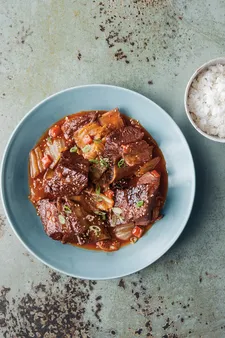Table of Contents
Embark on a culinary journey to the heart of Korean cuisine with Tauhuichiban's guide on How to make authentic Korean kimchi. As a staple in Korean households, kimchi is a fermented dish crafted from vegetables, typically napa cabbage and Korean radish, and seasoned with a vibrant symphony of spices and seasonings. Its unique flavor profile and health benefits have garnered it worldwide acclaim. In this comprehensive guide, we'll provide you with the essential knowledge and techniques to create your own authentic Korean kimchi, ensuring a delicious and authentic culinary experience.

How to Make Authentic Korean Kimchi: A Step-by-Step Guide to a Traditional Korean Delicacy
I. Ingredients for Authentic Korean Kimchi
- 1 large napa cabbage (about 2 pounds)
- 1 cup coarse sea salt
- 1 cup gochugaru (Korean red pepper powder)
- 1/2 cup fish sauce
- 1/2 cup glutinous rice flour
- 1/4 cup sugar
- 1/4 cup minced garlic
- 1/4 cup minced ginger
- 1/4 cup chopped green onions
- 1/4 cup chopped carrots
- 1/4 cup chopped daikon radish
II. Step-by-Step Guide to Making Authentic Korean Kimchi
Preparing the Vegetables
1. Cut the cabbage into 2-inch pieces.2. In a large bowl, combine the cabbage and salt.3. Massage the cabbage with the salt until it becomes wilted and releases its juices.4. Rinse the cabbage thoroughly with cold water and drain well.
Making the Kimchi Paste
1. In a large bowl, combine the gochugaru, fish sauce, glutinous rice flour, sugar, garlic, ginger, green onions, carrots, and daikon radish.2. Mix well to form a thick paste.
Fermenting the Kimchi
1. Add the kimchi paste to the cabbage and mix well.2. Transfer the kimchi to a clean glass jar or container.3. Press down on the kimchi to remove any air bubbles.4. Cover the jar or container with a lid and store it in a cool, dark place for at least 2 weeks.The kimchi will be ready to eat after 2 weeks, but it will continue to ferment and develop flavor over time.
Type of Kimchi | Main Ingredients | Region of Origin |
|---|---|---|
Baechu kimchi | Napa cabbage, gochugaru, fish sauce, glutinous rice flour, sugar, garlic, ginger, green onions, carrots, daikon radish | All regions of Korea |
Gat kimchi | Mustard greens, gochugaru, fish sauce, glutinous rice flour, sugar, garlic, ginger, green onions, carrots, daikon radish | Jeolla Province |
Chonggak kimchi | Radish, gochugaru, fish sauce, glutinous rice flour, sugar, garlic, ginger, green onions, carrots, daikon radish | Gyeongsang Province |
Kkakdugi | Cubed radish, gochugaru, fish sauce, glutinous rice flour, sugar, garlic, ginger, green onions, carrots, daikon radish | All regions of Korea |
Oi sobagi | Cucumber, gochugaru, fish sauce, glutinous rice flour, sugar, garlic, ginger, green onions, carrots, daikon radish | Jeju Island |
Kimchi is a traditional Korean side dish made from fermented vegetables, typically napa cabbage and Korean radish. It is a staple in Korean cuisine and is often served with rice, noodles, or soup. Kimchi is not only delicious, but it is also very healthy. It is a good source of probiotics, which are beneficial bacteria that can help to improve gut health. Kimchi is also a good source of vitamins and minerals, including vitamin C, vitamin K, and iron.
There are many different types of kimchi, each with its own unique flavor and ingredients. Some of the most popular types of kimchi include:
- Baechu kimchi: This is the most common type of kimchi, made with napa cabbage.
- Gat kimchi: This type of kimchi is made with mustard greens.
- Chonggak kimchi: This type of kimchi is made with radish.
- Kkakdugi: This type of kimchi is made with cubed radish.
- Oi sobagi: This type of kimchi is made with cucumber.
Kimchi is a versatile dish that can be enjoyed in many different ways. It can be eaten as a side dish, used as a condiment, or even used as an ingredient in other dishes. Kimchi is a delicious and healthy way to add flavor and nutrition to your meals.

Ingredients for Authentic Korean Kimchi
III. Step-by-Step Guide to Making Authentic Korean Kimchi
Preparing the Vegetables
To begin, you'll need to prepare the vegetables. Start by rinsing the napa cabbage thoroughly and cutting it into bite-sized pieces. Next, peel and slice the Korean radish into thin strips. Place the cabbage and radish in a large bowl and sprinkle with salt. Toss to combine and let sit for at least 2 hours, or overnight. This will help to draw out the excess moisture from the vegetables.
Once the vegetables have been salted, rinse them thoroughly with cold water and drain well. Transfer the vegetables to a clean bowl and add the gochugaru (Korean chili powder), gochujang (Korean chili paste), garlic, ginger, green onions, and sugar. Toss to combine until the vegetables are evenly coated.
Making the Kimchi Paste
While the vegetables are salting, you can make the kimchi paste. In a small bowl, combine the gochugaru, gochujang, garlic, ginger, green onions, and sugar. Add a little bit of water to thin out the paste, if necessary. Set aside.
Fermenting the Kimchi
Now it's time to ferment the kimchi. Transfer the vegetables and kimchi paste to a clean glass jar or container. Press down on the vegetables to remove any air bubbles. Cover the jar loosely with a lid and let it ferment at room temperature for 3-5 days. The kimchi will be ready to eat when it has developed a sour and spicy flavor.
Once the kimchi is fermented, store it in the refrigerator for up to 6 months. Enjoy it as a side dish, condiment, or ingredient in other dishes.
Ingredient | Amount |
|---|---|
Napa cabbage | 1 head |
Korean radish | 1/2 |
Salt | 1/2 cup |
Gochugaru (Korean chili powder) | 1 cup |
Gochujang (Korean chili paste) | 1/2 cup |
Garlic | 10 cloves |
Ginger | 1 tablespoon |
Green onions | 1/2 cup |
Sugar | 1/4 cup |
Here are some tips for making the best kimchi:
- Use fresh, high-quality ingredients.
- Don't be afraid to experiment with different proportions of ingredients to find your perfect flavor.
- Let the kimchi ferment for at least 3 days, but up to 6 months, for the best flavor.
- Store the kimchi in the refrigerator to keep it fresh.
Kimchi is a delicious and healthy side dish that can be enjoyed in many different ways. It's a great way to add some spice and flavor to your meals.
If you're looking for a more in-depth guide to making kimchi, check out our article on How to Make Authentic Korean Kimchi.
IV. Tips for Perfecting Your Authentic Korean Kimchi
When making authentic Korean kimchi, there are a few key tips to keep in mind to ensure the best possible results. First, it is important to use the right ingredients. The most important ingredient in kimchi is napa cabbage, which should be fresh and crisp. Other essential ingredients include Korean red pepper powder, garlic, ginger, and salt.Click here to find the best Korean restaurants in your city
Once you have gathered your ingredients, it is important to prepare them properly. The napa cabbage should be washed and cut into bite-sized pieces. The garlic and ginger should be minced, and the Korean red pepper powder should be mixed with a little bit of water to form a paste.Click here to learn more about the health benefits of Korean herbs and spices
Ingredient | Amount |
|---|---|
Napa cabbage | 1 head |
Korean red pepper powder | 1/2 cup |
Garlic | 10 cloves |
Ginger | 1 tablespoon |
Salt | 1/4 cup |
Once the ingredients are prepared, it is time to assemble the kimchi. In a large bowl, combine the napa cabbage, Korean red pepper paste, garlic, ginger, and salt. Mix well until the cabbage is evenly coated.Click here to learn more about the differences between regional cuisines in Korea
Once the kimchi is assembled, it is important to let it ferment. This process will allow the kimchi to develop its characteristic sour and spicy flavor. To ferment the kimchi, place it in a glass jar or other airtight container. Cover the kimchi with a lid and store it in a cool, dark place for at least 2 weeks.Click here to learn more about the secrets of Korean barbecue and hot pot cooking
After 2 weeks, the kimchi is ready to eat. It can be served as a side dish or used as an ingredient in other dishes. Kimchi is a delicious and healthy way to add flavor to your meals.
- Use fresh, crisp napa cabbage.
- Prepare the ingredients properly.
- Let the kimchi ferment for at least 2 weeks.
- Enjoy your delicious kimchi!

Tips for Perfecting Your Authentic Korean Kimchi
V. Troubleshooting Common Issues with Authentic Korean Kimchi
Overly Sour Kimchi
Excessive sourness in kimchi can be a sign of over-fermentation. To prevent this, control the fermentation process carefully by monitoring the temperature and the amount of time the kimchi ferments. You may wish to reduce the fermentation time, or maintain a cooler temperature for a slower fermentation.
Unfermented Kimchi
Kimchi that has not fermented adequately will lack its characteristic flavor and texture. Ensure that your kimchi is fermented for a sufficient amount of time, typically at least several days, to achieve the desired level of fermentation.
Leaking Kimchi
Leaking kimchi is often caused by excess moisture in the fermentation container. Make sure to drain off any excess liquid before sealing the container, and ensure the container is properly sealed to prevent further leakage.
Issue | Possible Cause | Solution |
|---|---|---|
Overripe or wilted vegetables | Use fresh, crisp vegetables for the best results. | |
Yeast or mold growth | Discard the kimchi. | |
Not enough red pepper flakes | Add more red pepper flakes to taste. |

Troubleshooting Common Issues with Authentic Korean Kimchi
VI. Conclusion
Congratulations on completing your journey to master the art of making authentic Korean kimchi! By following the detailed steps and incorporating our tips, you can now recreate this culinary gem in the comfort of your own kitchen. Remember, the fermentation process takes time, so be patient and allow your kimchi to fully develop its complex flavors. Making your own kimchi not only allows you to enjoy a delicious and authentic Korean dish but also provides numerous health benefits. The fermentation process produces probiotics that promote gut health, and the use of fresh vegetables ensures a rich source of vitamins and minerals. So, whether you're a seasoned kimchi enthusiast or embarking on this culinary adventure for the first time, embrace the process and savor the unique flavors of homemade kimchi. Share your creations with loved ones, or indulge in the satisfaction of enjoying a dish that is both delicious and beneficial to your health.